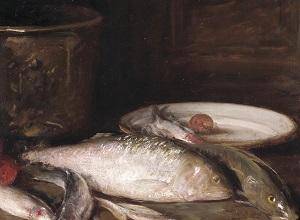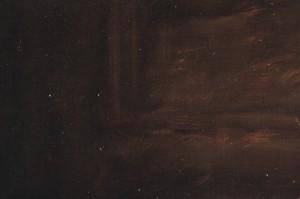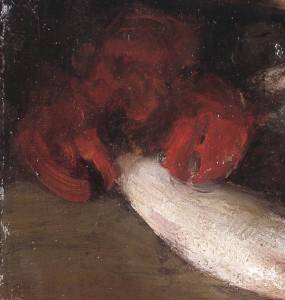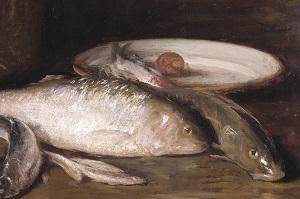Still Life with Fish
- William Merritt Chase, American, 1849-1916
- Born: New York
- Work Locations: New York
William Merritt Chase was born in Williamsburg, Indiana, and began his formal art training in New York before heading to Germany, where he studied at the Munich Royal Academy for six years. While Chase identified himself as a realist, painting realistic still-lifes and portraits, others classified him as one of America’s best artists painting in an impressionistic style. His body of work spans a wide range of subject matter: still-lifes, portraits, landscapes, and impressionistic views. He always championed skillful technique over distinguished subject matter, and delighted in turning humble or inelegant common objects into pleasing images. In Chase’s words, “If you can paint a pot, you can paint an angel.”
Chase taught for over 38 years and was very proud of his role as a teacher. His teaching career included the Art Students League in New York and his own outdoor art school on Long Island. Chase would tell his students, “Be in an absorbent frame of mind. Take the best from everything.” One of his well-known students, Georgia O’Keeffe, once described him: “There was something fresh and energetic about him that made him fun…To interest him, paintings had to be alive with paint and a kind of dash and go.” Even though he received recognition and honors throughout his career, Chase relied on teaching to support his family and to give him the financial stability to avoiding painting works for the mere sake of marketability. Chase died at the age of 66 after several months of illness.
William Merritt Chase enjoyed turning mundane subjects into pleasing images. As he said, “Paint the commonplace in such a way as to make it distinguished.” Because fish were objects of great beauty to Chase, he painted them frequently. In 1913, he remarked, “I enjoy painting fishes; in the infinite variety of these creatures, the subtle and exquisite colored tones of the flesh, fresh from the water, the way their surfaces reflect the light, I take the greatest pleasure…It may be that I will be remembered as a painter of fish.” Chase’s impressive technique drew attention and acclaim to his work, placing his still lifes with fish in high demand. His affinity for a dark palette and bold brushwork were influenced by his studies at the Munich Royal Academy.
Chase was notorious for painting quickly. His dashing painting demonstrations, in which he completed a major composition within a few hours, were legendary. A fish painting like ours usually took him less than a day to complete. He would douse the fish he used as models in ice water to keep them from smelling. Story has it that Chase once rented a fish in order to paint it and returned it still fresh enough to be sold.
Details

Related Elements
One scholar refers to this painting as a “kitchen piece” because of its lack of “elegance,” its association with daily life, and because the elements depicted are related to the preparation of a meal. The fish is displayed with objects that might be used to prepare it.

Fish Paired With Pot
Chase enjoyed painting copper pots, so his choice of including one in the composition was not only practical but also aesthetic. The pot creates a play of color and shine between its burnished gold and the shimmering silver fish, and also a play of texture between the slithering fish and the firm structure of the pot.

Signs of Speed
Chase was able to achieve a strong sense of realism without a high degree of detail. In this work there are several examples of his quick vigorous brushwork. Chase creates a convincing fin by simply dragging a flat, dry brush through wet paint. There are several spots on the copper pot where the canvas is still visible.

Dark Background
Chase admired many 17th century Dutch artists and hung copies of their paintings in his studio. By recreating the characteristic dark background used by these artists, Chase was able to better highlight the light silvery tones of his fish.

Color
Chase used color carefully in this painting to create a rich, warm atmosphere. The golden-brown foreground and background accentuate the silvery-grey fish, while the bright red of the lobster and onion balance and enliven the composition.

Repeated Curves
A group of dead fish gave Chase an opportunity to compose an elegant series of related curves. And by including the cooking pot and white plate, he could take the echoing shapes a step further.
More Resources
Websites
Art Renewal Center: William Merritt Chase
A website with brief biographical information, images of the artist, as well as several examples of his work.
William Merritt Chase Virtual Gallery
Includes biographical information and over 300 images of his work.
Books
Pisano, Ronald G., Alicia Grant Longwell. Photographs from the William Merritt Chase Archives at the Parrish Art Museum, Southampton, NY: Parrish Art Museum, 1992.
An introduction to William Merritt Chase’s life and work in addition to several photographs of the artist, his family, and his work.
Pisano, Ronald G.. William Merritt Chase, New York: Watson-Guptill Publications, 1979.
A nice and concise description of Chase’s life and work, including a chronology. The role of fish in Chase's work is discussed on page 82.
Funding for object education resources provided by a grant from the Morgridge Family Foundation. Additional funding provided by the William Randolph Hearst Endowment for Education Programs, and Xcel Energy Foundation. We thank our colleagues at the University of Denver Morgridge College of Education.
The images on this page are intended for classroom use only and may not be reproduced for other reasons without the permission of the Denver Art Museum. This object may not currently be on display at the museum.
